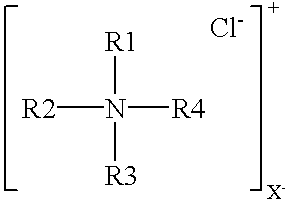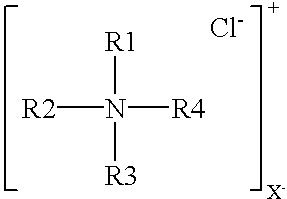Organoclay/polymer compositions with flame retardant properties
a technology of organic clay and polymer composition, which is applied in the field of organic clay/polymer compositions with flame retardant properties, can solve the problems of high cost of these specialized materials, specialized processing techniques that are required to achieve the effect of reducing the cost of specialized materials
- Summary
- Abstract
- Description
- Claims
- Application Information
AI Technical Summary
Benefits of technology
Problems solved by technology
Method used
Image
Examples
example 2
The organoclay from Example 1 was incorporated at 5.5% loading into a compounded TPO Elastomer formulation based on Adflex KS353P, a product of Montell, Inc. A variety of conditions was used. The resulting films were analyzed by X-Ray Diffraction and gave the following results:
Discussion of Results:
Table I above shows the peak heights and areas of the d.sub.001 reflection of the organoclay and the results of horizontal flame testing for each of the materials prepared. Peak information is expressed as the ratio to the crystalline polymer peak at 4.9 .ANG..
The data clearly show the correlation between the dispersion of the organoclay and the fire retardant properties of the polymer. Samples prepared under conditions 3 and 4 were subjected to significantly more shear in processing than the first two, and the delamination of the organoclay is apparent by the dramatic increase in polymer / organoclay peak heights and ratios as observed in the XRD spectrum. The samples which had a high degr...
PUM
| Property | Measurement | Unit |
|---|---|---|
| interlayer distances | aaaaa | aaaaa |
| cation exchange capacity | aaaaa | aaaaa |
| weight | aaaaa | aaaaa |
Abstract
Description
Claims
Application Information
 Login to View More
Login to View More - R&D
- Intellectual Property
- Life Sciences
- Materials
- Tech Scout
- Unparalleled Data Quality
- Higher Quality Content
- 60% Fewer Hallucinations
Browse by: Latest US Patents, China's latest patents, Technical Efficacy Thesaurus, Application Domain, Technology Topic, Popular Technical Reports.
© 2025 PatSnap. All rights reserved.Legal|Privacy policy|Modern Slavery Act Transparency Statement|Sitemap|About US| Contact US: help@patsnap.com


